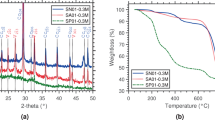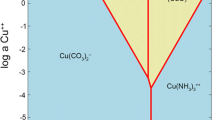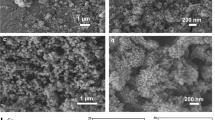Abstract
In an attempt to draw a correlation between calcium carbonate (CaCO3) precipitation and biomacromolecules such as extracellular polymeric substances and enzyme activity in biomineralizing microbe, this report aims to elucidate the ureolytic and ammonification route in Paenibacillus alkaliterrae to explore the possible role of organic biomolecule(s) present on cell surface in mediating nucleation and crystallization of biogenic CaCO3. After 168 h of biomineralization in ureolysis and ammonification, 2.2 g/l and 0.87 g/l of CaCO3 precipitates were obtained, respectively. The highest carbonic anhydrase activity (31.8 µmoles/min/ml) was evidenced in ammonification as opposed to ureolysis (24.8 µmoles/min/ml). Highest urease activity reached up to 9.26 µmoles/min/ml in ureolytic pathway. Extracellular polymeric substances such as polysaccharides and proteins were found to have a vital role not only in the nucleation and crystal growth but also in addition direct polymorphic fate of CaCO3 nanoparticles. EPS production was higher during ammonification (3.1 mg/ml) than in ureolysis (0.72 mg/ml). CaCO3 nanoparticle–associated proteins were found to be 0.82 mg/ml in ureolysis and 0.56 mg/ml in ammonification. After 30 days of biomineralization, all the polymorphic forms stabilized to calcite in ureolysis but in ammonification vaterite predominated. In our study, we showed that organic template–mediated prokaryotic biomineralization follows the non-classical nucleation and varying proportions of these organic components causes selective polymorphism of CaCO3 nanoparticles. Overall, the findings are expected to further the fundamental understanding of enzymes, EPS-driven non-classical nucleation of CaCO3, and we foresee the design of fit-for-purpose futuristic biominerals arising from such renewed understanding of biomineralization.
Key points
• Organic-inorganic interface of cell surface promote crystallization of biominerals
• Carbohydrate and proteins in the interface results selective polymorphism of CaCO3
• Calcite stabilized at 30 days in ureolysis, vaterite-calcite mix in ammonification
Graphical Abstract











Similar content being viewed by others
Data availability
All data generated or analyzed during this study are included in this article and its supplementary material.
References
Chen L, Shen Y, Xie A, Huang F, Zhang W, Liu S (2010) Seed-mediated synthesis of unusual struvite hierarchical superstructures using bacterium. Cryst Growth Des 10:2073–2082. https://doi.org/10.1021/cg900974n
Chen Y, Wang S, Tong XY, Kang X (2022) Crystal transformation and self-assembly theory of microbially induced calcium carbonate precipitation. Appl Microbiol Biotechnol 106:3555–3569. https://doi.org/10.1007/s00253-022-11938-7
Dhami NK, Reddy MS, Mukherjee A (2014) Synergistic role of bacterial urease and carbonic anhydrase in carbonate mineralization. Appl Biochem Biotechnol 172:2552–2561. https://doi.org/10.1007/s12010-013-0694-0
Ding Y, Shi L, Wei H (2014) Protein-directed approaches to functional nanomaterials: a case study of lysozyme. J Mater Chem B 2:8268–8291. https://doi.org/10.1039/c4tb01235f
Enyedi NT, Makk J, Kótai L, Berényi B, Klébert S, Sebestyén Z, Molnár Z, Borsodi AK, Leél-Őssy S, Demény A, Németh P (2020) Cave bacteria-induced amorphous calcium carbonate formation. Sci Rep 10:1–12. https://doi.org/10.1038/s41598-020-65667-w
Fallis A (2013) FTIR spectrum analysis. Lecture notes. J Chem Inf Model 53:1689–1699. https://doi.org/10.1017/CBO9781107415324.004
Fishbein WN (1969) Urease catalysis. J Biol Chem 244:1188–1193. https://doi.org/10.1016/s0021-9258(18)91828-4
Gat D, Ronen Z, Tsesarsky M (2017) Long-term sustainability of microbial-induced CaCO3 precipitation in aqueous media. Chemosphere 184:524–531. https://doi.org/10.1016/j.chemosphere.2017.06.015
Gowthaman S, Yamamoto M, Nakashima K, Ivanov V, Kawasaki S (2021) Calcium phosphate biocement using bone meal and acid urease: an eco-friendly approach for soil improvement. J Clean Prod 319:128782. https://doi.org/10.1016/j.jclepro.2021.128782
Ihli J, Wong WC, Noel EH, Kim YY, Kulak AN, Christenson HK, Duer MJ, Meldrum FC (2014) Dehydration and crystallization of amorphous calcium carbonate in solution and in air. Nat Commun 5:1–10. https://doi.org/10.1038/ncomms4169
Jain S, Fang C, Achal V (2021) A critical review on microbial carbonate precipitation via denitrification process in building materials. Bioengineered 12:7529–7551. https://doi.org/10.1080/21655979.2021.1979862
Jaishankar J, Srivastava P (2017) Molecular basis of stationary phase survival and applications. Front Microbiol 8:1–12. https://doi.org/10.3389/fmicb.2017.02000
Karthika S, Radhakrishnan TK, Kalaichelvi P (2016) A review of classical and nonclassical nucleation theories. Cryst Growth Des 16:6663–6681. https://doi.org/10.1021/acs.cgd.6b00794
Khanjani M, Westenberg DJ, Kumar A, Ma H (2021) Tuning polymorphs and morphology of microbially induced calcium carbonate: controlling factors and underlying mechanisms. ACS Omega 6:11988–12003. https://doi.org/10.1021/acsomega.1c00559
Kim HJ, Shin B, Lee YS, Park W (2017) Modulation of calcium carbonate precipitation by exopolysaccharide in Bacillus sp. JH7. Appl Microbiol Biotechnol 101:6551–6561. https://doi.org/10.1007/s00253-017-8372-8
Konstantinou C, Wang Y, Biscontin G, Soga K (2021) The role of bacterial urease activity on the uniformity of carbonate precipitation profiles of bio-treated coarse sand specimens. Sci Rep 11:1–17. https://doi.org/10.1038/s41598-021-85712-6
Lambrechts C, Galzy P (1995) Esterase activities of Brevibacterium sp. R312 and Brevibacterium linens 62. Biosci Biotechnol Biochem 59:1464–1471. https://doi.org/10.1271/bbb.59.1464
Li Q, Gadd GM (2017) Biosynthesis of copper carbonate nanoparticles by ureolytic fungi. Appl Microbiol Biotechnol 101:7397–7407. https://doi.org/10.1007/s00253-017-8451-x
Li W, Liu L, Chen W, Yu L, Li W, Yu H (2010) Calcium carbonate precipitation and crystal morphology induced by microbial carbonic anhydrase and other biological factors. Process Biochem 45:1017–1021. https://doi.org/10.1016/j.procbio.2010.03.004
Liu F, Csetenyi L, Gadd GM (2019) Amino acid secretion influences the size and composition of copper carbonate nanoparticles synthesized by ureolytic fungi. Appl Microbiol Biotechnol 103:7217–7230. https://doi.org/10.1007/s00253-019-09961-2
Liu F, Shah DS, Gadd GM, Liu F, Shah DS, Gadd GM (2021a) Article role of protein in fungal biomineralization of copper carbonate nanoparticles ll ll role of protein in fungal biomineralization of copper carbonate nanoparticles. Curr Biol 31:358-368.e3. https://doi.org/10.1016/j.cub.2020.10.044
Liu R, Huang S, Zhang X, Song Y, He G, Wang Z, Lian B (2021b) Bio-mineralisation, characterization, and stability of calcium carbonate containing organic matter. RSC Adv 11:14415–14425. https://doi.org/10.1039/D1RA00615K
Nawarathna THK, Nakashima K, Kawasaki S (2019) Chitosan enhances calcium carbonate precipitation and solidification mediated by bacteria. Int J Biol Macromol 133:867–874. https://doi.org/10.1016/j.ijbiomac.2019.04.172
Ogino T, Suzuki T, Sawada K (1987) The formation and transformation mechanism of calcium carbonate in water. Geochim Cosmochim Acta 51:2757–2767. https://doi.org/10.1016/0016-7037(87)90155-4
Olderay M, Xie M, Strand BL, Flaten EM, Sikorski P, Andreassen JP (2009) Growth and nucleation of calcium carbonate vaterite crystals in presence of alginate. Cryst Growth Des 9:5176–5183. https://doi.org/10.1021/cg9005604
Pérez-Villarejo L, Takabait F, Mahtout L, Carrasco-Hurtado B, Eliche-Quesada D, Sánchez-Soto PJ (2018) Synthesis of vaterite CaCO3 as submicron and nanosized particles using inorganic precursors and sucrose in aqueous medium. Ceram Int 44:5291–5296. https://doi.org/10.1016/j.ceramint.2017.12.142
Radha AV, Forbes TZ, Killian CE, Gilbert PUPA, Navrotsky A (2010) Transformation and crystallization energetics of synthetic and biogenic amorphous calcium carbonate. Proc Natl Acad Sci U S A 107:16438–16443. https://doi.org/10.1073/pnas.1009959107
Rodriguez-Blanco JD, Shaw S, Benning LG (2011) The kinetics and mechanisms of amorphous calcium carbonate (ACC) crystallization to calcite, via vaterite. Nanoscale 3:265–271. https://doi.org/10.1039/c0nr00589d
Rodriguez-Navarro C, Jimenez-Lopez C, Rodriguez-Navarro A, Gonzalez-Muñoz MT, Rodriguez-Gallego M (2007) Bacterially mediated mineralization of vaterite. Geochim Cosmochim Acta 71:1197–1213. https://doi.org/10.1016/j.gca.2006.11.031
Simon P, Pompe W, Gruner D, Sturm E, Ostermann K, Matys S, Vogel M, Rödel G (2022) Nested formation of calcium carbonate polymorphs in a bacterial surface membrane with a graded nanoconfinement: an evolutionary strategy to ensure bacterial survival. ACS Biomater Sci Eng 8:526–539. https://doi.org/10.1021/acsbiomaterials.1c01280
Tambutté E, Tambutté S, Segonds N, Zoccola D, Venn A, Erez J, Allemand D (2011) Calcein labelling and electrophysiology: insights on coral tissue permeability and calcification. Proc R Soc B Biol Sci 279:19–27. https://doi.org/10.1098/rspb.2011.0733
Tong H, Ma W, Wang L, Wan P, Hu J, Cao L (2004) Control over the crystal phase, shape, size and aggregation of calcium carbonate via a L-aspartic acid inducing process. Biomaterials 25:3923–3929. https://doi.org/10.1016/j.biomaterials.2003.10.038
Tourney J, Ngwenya BT (2009) Bacterial extracellular polymeric substances (EPS) mediate CaCO3 morphology and polymorphism. Chem Geol 262:138–146. https://doi.org/10.1016/j.chemgeo.2009.01.006
Tourney J, Ngwenya BT (2014) The role of bacterial extracellular polymeric substances in geomicrobiology. Chem Geol 386:115–132. https://doi.org/10.1016/j.chemgeo.2014.08.011
Vidallon MLP, Yu F, Teo BM (2020) Controlling the size and polymorphism of calcium carbonate hybrid particles using natural biopolymers. Cryst Growth Des 20:645–652. https://doi.org/10.1021/acs.cgd.9b01057
Wierzbicki A, Sikes CS, Madura JD, Drake B (1994) Atomic force microscopy and molecular modeling of protein and peptide binding to calcite. Calcif Tissue Int 54:133–141. https://doi.org/10.1007/BF00296064
Wolf SE, Gower LB (2017) Challenges and perspectives of the polymer-induced liquid-precursor process: the pathway from liquid-condensed mineral precursors to mesocrystalline products. In: Van Driessche AES, Kellermeier M, Benning LG, Gebauer D (eds) New perspectives on mineral nucleation and growth, 1st edn. Springer International Publishing, Switzerland, pp 43–75
Yan Z, Gowthaman S, Nakashima K, Kawasaki S (2022) Polymer-assisted enzyme induced carbonate precipitation for non-ammonia emission soil stabilization. Sci Rep 12:1–11. https://doi.org/10.1038/s41598-022-12773-6
Yang G, Li L, Li F, Zhang C, Lyu JJ (2021) Mechanism of carbonate mineralization induced by microbes: taking Curvibacter lanceolatus strain HJ-1 as an example. Micron 140:102980. https://doi.org/10.1016/j.micron.2020.102980
Yoshida N, Higashimura E (2010) Catalytic biomineralization of fluorescent calcite by the thermophilic bacterium Geobacillus thermoglucosidasius. Appl Environ Microbiol 76:7322–7327. https://doi.org/10.1128/AEM.01767-10
Yu X, Chu J, Yang Y, Qian C (2021) Reduction of ammonia production in the biocementation process for sand using a new biocement. J Clean Prod 286:124928. https://doi.org/10.1016/j.jclepro.2020.124928
Zhang C, Li F, Sun J, Lv J (2020) Controlled crystallization and transformation of carbonate minerals with dumbbell-like morphologies on bacterial cell templates. Microsc Microanal 26:275–286. https://doi.org/10.1017/S1431927620000057
Zhu T, Dittrich M (2016) Carbonate precipitation through microbial activities in natural environment, and their potential in biotechnology: a review. Front Bioeng Biotechnol 4:1–21. https://doi.org/10.3389/fbioe.2016.00004
Acknowledgements
The authors thank the Department of Biotechnology and Central Research Facility (CRF) of IIT Kharagpur for providing necessary research facilities. BioRender.com is duly acknowledged for creation of images. The authors are thankful to Prof. Abhijit Mukherjee, John Curtin Distinguished Professor, Structural Engineering, School of Civil and Mechanical Engineering and Dr. Navdeep Dhami, Senior Lecturer, School of Molecular and Life Sciences, Curtin University, Perth, Australia for their insightful scientific inputs during their visit to IIT Kharagpur.
Funding
The authors gratefully acknowledge the DBT-JRF fellowship (Fellow No. DBT/2018/IIT-KH/1012) New Delhi, India, to Ankita Debnath and Scheme of Young Scientists and Technologists (SYST) (File no.: SP/YO/530/2018, 08/10/2018), Department of Science and Technology (DST), Government of India to Chinmay Hazra for financial support. The authors also acknowledge financial assistance from 'Scheme for Promotion of Academic and Research Collaboration' [SPARC, MHRD, New Delhi] (SPARC/2018-2019/P409/SL,Dt.11-07-2019).
Author information
Authors and Affiliations
Contributions
RS: conceptualization, validation, writing—review and editing draft, resources, and supervision; AD: experiments and analysis, methodology, validation, and writing—original draft; CH: validation and writing—review and editing draft.
Corresponding author
Ethics declarations
Ethical approval
This article does not contain any studies with human participants or animals performed by any of the authors.
Conflict of interest
The authors declare no competing interests.
Additional information
Publisher's note
Springer Nature remains neutral with regard to jurisdictional claims in published maps and institutional affiliations.
Supplementary Information
Below is the link to the electronic supplementary material.
Rights and permissions
Springer Nature or its licensor (e.g. a society or other partner) holds exclusive rights to this article under a publishing agreement with the author(s) or other rightsholder(s); author self-archiving of the accepted manuscript version of this article is solely governed by the terms of such publishing agreement and applicable law.
About this article
Cite this article
Debnath, A., Hazra, C. & Sen, R. Insight into biomolecular interaction–based non-classical crystallization of bacterial biocement. Appl Microbiol Biotechnol 107, 6683–6701 (2023). https://doi.org/10.1007/s00253-023-12736-5
Received:
Revised:
Accepted:
Published:
Issue Date:
DOI: https://doi.org/10.1007/s00253-023-12736-5




